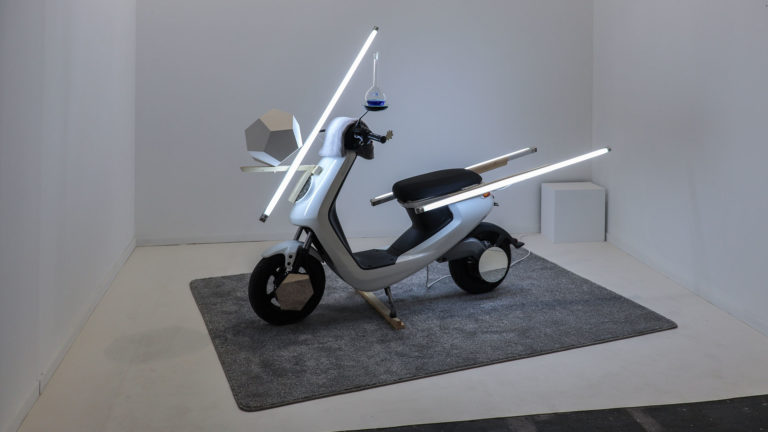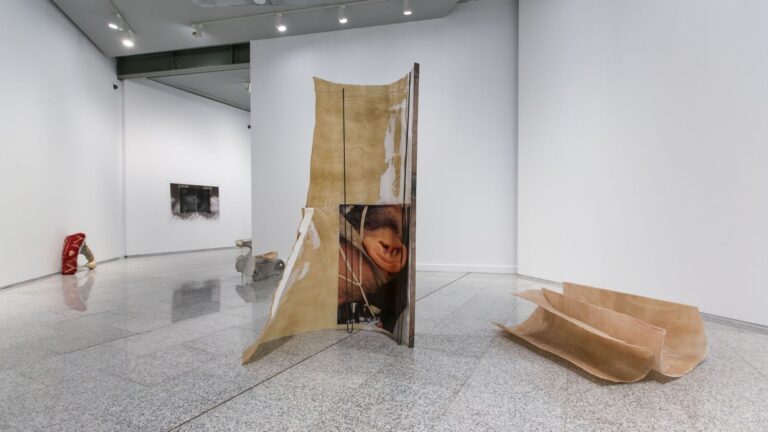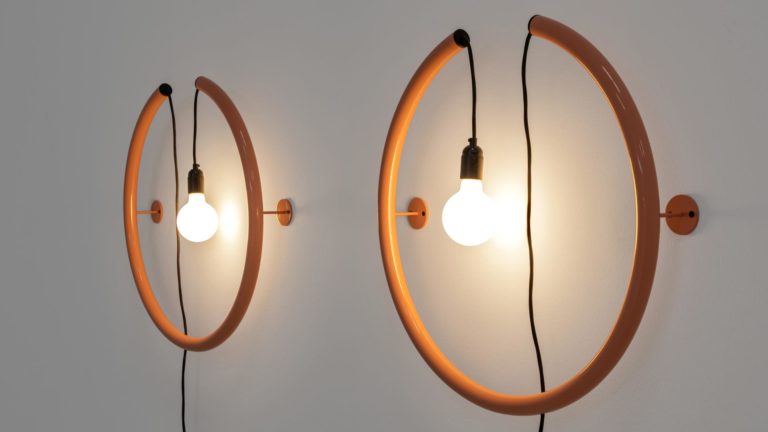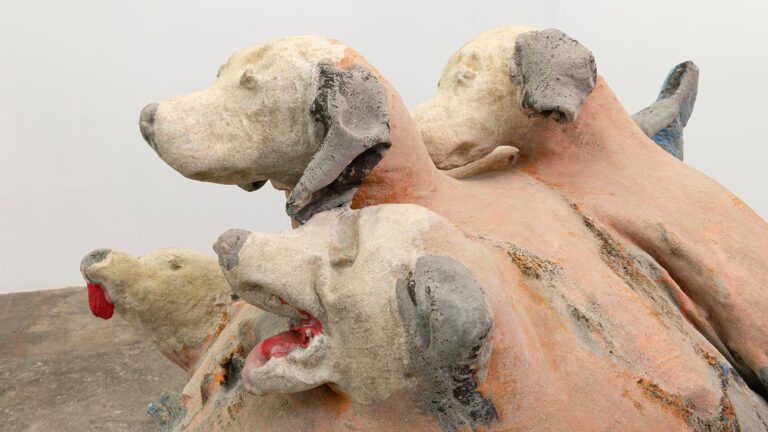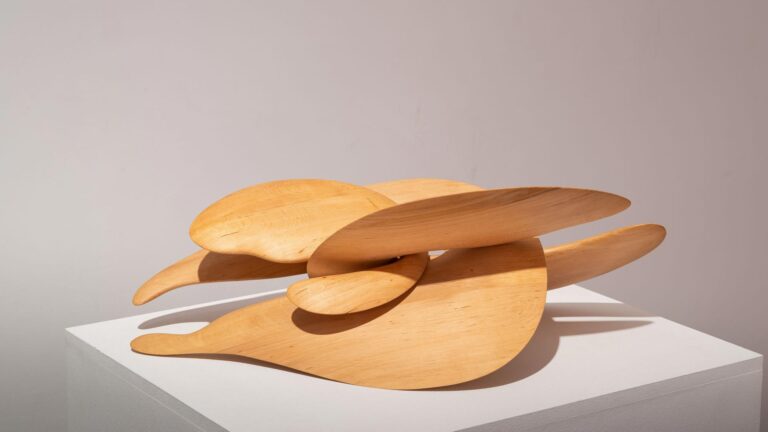Artist: Abel Jaramillo
Exhibition title: El fuego le canta al sol
Venue: Galería Fran Reus, Mallorca, Spain
Date: September 15 – November 1, 2022
Photography: Grimalt de Blanch / all images copyright and courtesy of the artist and Galería Fran Reus, Mallorca
The project continues the search for traces of Celestino Coronado (Puebla de Sancho Pérez, Badajoz, 1944 – London, 2014), an experimental filmmaker and theatre director, who maintained close connections with music, literature, and theatre in his films. His filmography mainly spans the 1970s and 1980s, followed by years of unfinished projects. After his death in 2014, much of his output remains lost or forgotten. Videotapes, film reels, notes, scripts, and photographs of his work seem to have disappeared, scattered in some London rake.
I
In February 2020 I visited Jolonque for the first time. Jolonque is an estate in the Lecrín Valley (Granada), which was for years the home of the Chilean composer Carlos Miranda, a friend and regular collaborator of Coronado. Jesús Rey and Christoph Ehlers, close friends of both Coronado and Miranda, currently live there. On this first visit I was able to take some photographs and a series of video recordings of all the material that Jesús was showing me during the after-dinner conversation. Most of the images I had from that first visit were of Jesús’ hands moving through photographs, scripts and postcards, like a narrative by touch.
On my first visit to Jolonque that February, I remember a very particular sensation. Going down the small stairs to the living room, I see a piece of furniture next to the window, like a hall, where there are some keys, a candle, some pencils and loose papers in a bowl. In the background, a framed photograph of Celestino Coronado holding a banner reading: Fight Franco Fascism. Hanging from the frame of the photograph was an accreditation for a film festival that read: Cabochon Films, Coronado’s production company. This is the first photograph I took in Jolonque. A scene that looked like a small pagan altar that was integrated into the everyday life of the house, a presence that welcomed you and seemed to tell me that I was in the right place.
II
In the summer of 2021 I returned to Jolonque to visit Jesús and Christoph, this time for a week. We spent those days reading letters and scripts, watching films, and walking around Jolonque. Most of the time I was accompanied by my camera. I recorded for hours every day almost everything that happened: readings, landscapes, sounds and silences.
Jolonque was a place to go to without a script, without knowing exactly what I wanted to tell. The search for Celestino took me to Jolonque and there I found another story. A choral story, which was that of Jesús, Christoph, Carlos and Celestino, which was the story of other affective structures, of other ways of caring for each other, and of being a family. Jolonque contains an archive generated from affection and friendship, which transcends oblivion. An archive that does not think of being an archive, a tactful archive, made by groping. A place that is magic and alchemy, a place where Celestino Coronado was never there, but which speaks of him. The voice of Jesús structures a search around fragments of cinema, oral narrations, images and stories that the world had wanted to forget, but which were present there. Another way of remembering: the place of the stories that are written in small letters.
III
Every morning he goes to pick almonds. Walking, drinking plenty of water and eating almonds are beneficial exercises for the memory. Every morning he returns from a long walk with almonds in his pockets. Like every morning, he empties his pockets full of almonds into a long corridor where the almonds from previous days are piled up. A daily gesture that is also memory. The image of a column of almonds stretching across the floor of the corridor. Collecting what remains of that scene: the shell, the wrapping, the surface. And lift the image.
IV
The film was to be shot in Seville. They met there to write the script for the film about the history of gypsies and flamenco in Seville. A song for Lola, a scene in which Juan Montoya heels, a café for singers. The film was never shot and it seemed that it was never written either. “We only had a brief synopsis”, he told me. Looking through folders and old papers, there it was: the script of Serva la Bari (El bosque sagrado), written by Jesús Rey and Celestino Coronado.
Jesus tearfully recites a few verses of what could be one of the songs from that film: “Fire sings to the sun, who is the master of fires”
V
He signed those letters as Starless, because sometimes you live with your ghosts and sometimes you are the ghost.
VI
What is probably one of Celestino Coronado’s last film projects was a script idea for an adaptation of Shakespeare’s King Lear set in Zafra, Badajoz. A project about the passage of time and old age. A sketch that suggested a possible return: to go back to the roots, to return one day.
A possible film, which could have been and wasn’t, like so many others.
A possible return, someone who had to leave and did not return, like so many others.
VII
Flor estampada en la tela de algodón. Violeta. Jolonque. Flor de la viuda.
Ir a tientas. Dar un tiento.
Tentar a la suerte.
Suerte de no pincharme con la chumbera. Sangre como zumo de higo chumbo.
La cáscara seca. Las manos mojadas,
de higo.
Tentador.
Tiento, herramienta del pintor.
Tiento, palo flamenco.
Y la memoria, almendra amarga; corazón, de almendra amarga.
Tentativa.
La última que te escribo.
Abel Jaramillo, El fuego le canta al sol, 2022, exhibition view, Galería Fran Reus, Mallorca
Abel Jaramillo, El fuego le canta al sol, 2022, exhibition view, Galería Fran Reus, Mallorca
Abel Jaramillo, Jolonque (2022), Colour video Full HD , sound, 36 min
Abel Jaramillo, Secuencia seis. (Bolero) (2022), Wood, acoustic insulation, almond shells, prickly pear juice, graphite, ink, wire, paper, cold porcelain and natural mallow flower powder, 120 x 60 x 25 cm
Abel Jaramillo, Camino y columna (de la almendra amarga) (2022), Dipthic, Digital photography on metracrylate, wood and almond shells, 53x50x5cm
Abel Jaramillo, El fuego le canta al sol, 2022, exhibition view, Galería Fran Reus, Mallorca
Abel Jaramillo, Tiento amargo (2022), Digital print on fabric, wood, almond shells, dried fig shells, dried widow’s flowers, cotton printed with natural flowers, plaster and prickly pear juice, 110 x 30 x 40 cm
Abel Jaramillo, III (Serva la Bari) (2022), Digital photography on Hahnemühle paper, 50x40cm
Abel Jaramillo, Solos. Parece que están solos (2022), Wood, almond shells, prickly pear juice, graphite, ink, olive oil, walnut, wire, paper, cold porcelain and natural mallow flower powder, 30 x 70 x 50 cm aprox
Abel Jaramillo, S/T (Flores I) (2022), cold porcelain, 8 x 5 cm
Abel Jaramillo, A Jolonque (Amargo) (2022) Text, Digital print on paper, Multiple Ed, 30 x 20 cm
Abel Jaramillo, El fuego le canta al sol, 2022, exhibition view, Galería Fran Reus, Mallorca













